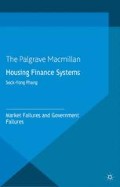Abstract
This chapter reviews the use of taxes and subsidies as instruments of housing policy as these are the most commonly utilized instruments that operate through markets. The housing sector is affected by a large variety of taxes and subsidies. Other than direct taxes and subsidies, in many developed countries, subsidies are funded through tax relief in the form of exemptions, deductions and credits (collectively known as tax expenditures). These provisions vary greatly across countries, depending on government policy objectives with regard to housing. These objectives include (i) support for low-income households; (ii) support for homeownership; (iii) housing supply and investment incentives that are tenure neutral or favor either renting or owning; (iv) raising revenue for local governments, (v) reducing housing wealth inequalities; and (vi) ensuring less-volatile house prices.
Access this chapter
Tax calculation will be finalised at checkout
Purchases are for personal use only
Preview
Unable to display preview. Download preview PDF.
Notes
Denise DiPasquale, Dennis Fricke and Daniel Garcia-Diaz, “Comparing the Costs of Federal Housing Assistance Programs”, Federal Reserve Bank of New York Policy Review, June 2003, pp. 147–166.
See Novogradac and Company LLP, “Low-Income Housing Tax Credit: Assessment of Program Performance and Comparison to Other Federal Affordable Rental Housing Subsidies”, Special Report, 2011 (http://www.novoco.com/products/special_report_lihtc.php).
See Erica Greulich and John M. Quigley, “Housing Subsidies and Tax Expenditures: The Case of Mortgage Credit Certificates”, Regional Science and Urban Economics, Vol. 39, No. 6, 2009, pp. 647–657. The study suggests that California’s MCC program provides substantial benefits to recipient households, averaging US $1,100 in the first year and US $10,400 in present value terms over the life of a 30-year mortgage. These subsidies decreased the user cost of housing to recipients by an average of more than 20 per cent.
PricewaterhouseCooper, “Too Good to Be True?” China Economic Review, 1 November 1998 (http://www.chinaeconomicreview.com/node/23397).
If taxed separately, both partners can claim it. See Christophe Andre, “A Bird’s Eye View of OECD Housing Markets” (OECD Economics Department Working Papers, No. 746, 2010).
This section on France draws mainly from Anne Laferrere and David Le Blanc, “Housing Policy: Low-Income Policy in France”, chapter 10 in Richard Arnott and Daniel McMillen (eds.), A Companion to Urban Economics (Malden, MA: Blackwell, 2006). PAP refers to Pret en accession a la propriete and PC to Pret conventionne.
See also Julie Lawson and Vivienne Milligan, “International Trends in Housing and Policy Responses” (Australia Housing and Urban Research Institute, Sydney Research Centre, AHURI Final Report No. 110, 2007), p. 68. PTZ refers to Pret a taux zero and PAS to Pret a l’accession sociale.
Sijbren Cnossen, “A Proposal to Improve the VAT Treatment of Housing in the European Union”, Fiscal Studies, Vol. 32, No. 4, 2011, pp. 455–481.
See Hui Shan, “The Effect of Capital Gains Taxation on Home Sales: Evidence from the Taxpayer Relief Act of 1997”, Journal of Public Economics, Vol. 95, No. 1–2, 2011, pp. 177–188.
Peter Englund, “Taxing Residential Housing Capital”, Urban Studies, Vol. 40, No. 5–6, 2003, pp. 937–952.
See Arthur O’Sullivan, Urban Economics, 8th ed. (New York: McGraw Hill, 2011), chapters 15 and 16.
See Richard F. Dye and Richard W. England, “Assessing the Theory and Practice of Land Value Taxation (Policy Focus Report)” (Lincoln Institute of Land Policy, Cambridge, MA, 2010).
Author information
Authors and Affiliations
Copyright information
© 2013 Sock-Yong Phang
About this chapter
Cite this chapter
Phang, SY. (2013). Taxes and Subsidies. In: Housing Finance Systems. Palgrave Macmillan, London. https://doi.org/10.1057/9781137014030_4
Download citation
DOI: https://doi.org/10.1057/9781137014030_4
Publisher Name: Palgrave Macmillan, London
Print ISBN: 978-1-349-43677-4
Online ISBN: 978-1-137-01403-0
eBook Packages: Palgrave Economics & Finance CollectionEconomics and Finance (R0)

